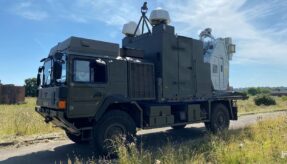
Writing for Defence Online, Head of Client Engagement at QinetiQ, David Rosewell, examines the challenges and innovations for defence in reducing emissions. QinetiQ is an official DPRTE 2021 event partner.
You can open any newspaper or web page these days and find at least one story on the ongoing climate debate. The current pandemic aside, climate change has become humanity’s greatest challenge. The UK’s legally binding target to be a net-zero emitter by 2050 is held as a world standard for setting out government policy towards cutting carbon emissions.
Transport accounts for up to 30% of global emissions, making it a key target in the bid to reduce global fossil fuels. This doesn’t just stop at commercial aviation and personal transport, but national transport solutions as well, especially in defence. For instance, the US military’s liquid fuel consumption is roughly equivalent to that of the whole of Portugal; 40% of this is attributable to facilities, with the rest coming from vehicles and equipment.
There is clearly a strong case to reduce emissions from land, sea and air transportation of all kinds across defence. So, what are the current challenges and latest innovations in the commercial and defence sectors, and is there any crossover between the two?
On land
European Union (EU) data shows that road vehicles account for a staggering 72% of emissions from transportation. Thankfully, after decades of failing to capture the public’s enthusiasm, electric car manufacturers have seen a remarkable surge in demand in recent years. Global sales increased by 43% in 2020, and falling battery costs mean the manufacture of electric cars is forecast to reach cost parity with that of combustion engine vehicles within the next five years. Historically, along with the higher price tag, ‘range anxiety’ and lengthy charging times have been major barriers to mass adoption of electric vehicles. But these concerns are now being addressed, with cars already capable of travelling over 450km between charges, and batteries in development that promise to deliver 100 miles of charge in just five minutes.
These advances are good news for defence departments seeking to lower their carbon footprints. According to the latest available figures from the UK MOD, domestic business travel accounts for approximately 10% of its total carbon emissions, and over 85% of that is from civilian road vehicles. The introduction of electric cars into defence departments’ civilian vehicle fleets would be a significant step in reducing emissions.
The electrification of front line fleets is more complex, as there is a more urgent emphasis on performance – but there are opportunities to safely reduce the carbon output of tanks and other armoured vehicles. Electric drive systems are currently making their way onto operational platforms, with hybrid technology currently being tested on the British Army’s Foxhound and Jackal 2 vehicles.
Far from compromising capability, electric drive technologies open up new design possibilities that enhance performance and protection. Replacing mechanical transmissions with electrically wired systems can reduce weight and increase usable space within the vehicle. The weight reduction can be used to improve power and agility or offset the burden of additional armour or weaponry. Other advantages include silent running for greater stealth; power provision for novel capabilities, such as directed energy weapons; and a reduction in risk from the presence of mechanical parts, which can turn to shrapnel in the event of an explosion beneath the vehicle.
There are currently three models of car on the civilian market powered by hydrogen fuel cells, although uptake of the technology has so far been dwarfed by that of electric vehicles. Lack of supporting infrastructure remains a deterrent for buyers – the UK has fewer than 20 hydrogen refuelling centres, compared to its 35,000 electric charging points. Significant investment is needed very soon if the hydrogen car is to avoid its Betamax moment. There are positive signs elsewhere, such as the Hydrogen Energy Supply Chain (HESC) – a joint Japanese-Australian project intended to produce plentiful, affordable fuel for Japan.
In defence, the idea of hydrogen-powered military vehicles has been floated by manufacturers for a number of years. General Motors demonstrated a hydrogen-fuelled Chevrolet Colorado ZH2 in 2017 seeking to catch the eye of the US Army, and the US Department of Defense (DoD) is reportedly examining a hydrogen-powered tank. However, development lags behind the more established electric and hybrid technologies. Hydrogen fuel cells may find a more hospitable market in the haulage industry, whose large lorries account for up to 70% of EU CO2 emissions from heavy-duty vehicles. The physical frame of a truck lends itself to carrying high-volume hydrogen tanks, plus it is faster to refuel a hydrogen cell than recharge an equivalent battery, reducing costly downtime. Trains are another likely contender, with Germany having unveiled the world’s first hydrogen-powered train in 2016, and the UK conducting similar trials last year.
At sea
Maritime transportation is responsible for nearly 14% of emissions from the EU transport sector, and up to 4% of global greenhouse gas emissions overall. As a sector, shipping is currently heading in the wrong direction in terms of cutting emissions. A 2014 study by the International Maritime Organisation found that if ‘business as usual’ continues, shipping emissions could increase by as much as 250% by 2050. There is clearly much work to do to slow that trend, let alone reverse it, but this progress is being hampered by regulatory loopholes that mean no country or company is required to take responsibility for carbon emissions produced by its international shipping activity. A more integrated approach is needed if the ambitious target of a 90% emissions reduction is to be met.
The practice of ‘slow steaming’ has been touted as an easy win for the short-term reduction of greenhouse gas emissions from shipping. Simply reducing the speed of a containership by 10% can reduce its emissions by 27%. However, this is impractical for the movement of perishable goods, and unpopular with shipping companies due to its negative impact on fleet availability and productivity. Technological solutions will be necessary to meet these challenges, such as novel hull and propeller shapes optimised for efficiency, or alternative power sources like electricity or liquid natural gas (LNG). Dutch company Port Liner has developed an uncrewed electric container barge, dubbed the ‘Tesla of the canals.’ Charged on shore with carbon-free energy, each barge can transport loads of up to 425 tonnes along the inland waterways of Belgium and the Netherlands – although their batteries’ 15-hour runtime make them unsuitable for long sea journeys.
One potential long-term solution currently being discussed for international freight shipping is a technology used in defence since the 1960s: nuclear power. UK start-up Core Power has designed a molten salt reactor, likened to a ‘nuclear battery,’ which it claims can fuel a ship carbon-free for its entire 30-year service life. In November 2020 the company announced a partnership with nuclear innovation company TerraPower alongside utility firm Southern Company and nuclear tech company Orano USA. The team has applied for funding from the US Department of Energy to build a prototype.
Although a handful of naval vessels already have the nuclear edge over commercial ships, there is plenty of room for overall improvement in defence’s maritime domain. Many navy ships are still in the early years of their service life and will not be replaced for decades. The UK’s Type 23 Frigate, for example, will remain in service until the mid-2030s. Faced with the challenge of reducing emissions, the Royal Navy has turned to hydrodynamic improvements, including a new propeller design that could improve efficiency by 2.5%, and a rudder that could offer a 3% saving based on reduction in underwater drag. While this progress is welcome, big gains are unlikely to be made until a radical new, greener generation of warship is brought into service – which may not happen until after the 2050 milestone.
In the air
Civil aviation’s contribution to EU transport emissions is comparable to that of maritime travel, and is responsible for around 2% of all CO2 produced by humans globally. Today’s aircraft are over much more efficient than those built in the 1960s, driven by incremental advances in materials, structures, propulsion and aerodynamics. However, to meet the 2050 target, aircraft design will need to undergo a monumental shift from evolutionary to revolutionary progress.
Unlike electric cars, electric aircraft technology is very much in its infancy. Several concepts have been built and tested. But the dream of an all-electric long-haul passenger airliner remains out of reach for now, due mainly to the insufficient energy density of existing batteries. At present, an aircraft with a battery capable of sustaining intercontinental flight with 200 passengers on board would be too heavy to take off. Many of aviation’s more achievable CO2-reduction goals are based around ‘more-electric’ aircraft, in which electricity is used for everything except propulsion; or hybrid models, which may use conventional jet engines for take-off and ascent before switching to electric motors for cruising.
Aviation currently accounts for nearly two thirds of fuel used across UK defence – but one type of aircraft that is unlikely to ever go all-electric is the crewed fighter jet. The performance demands far outstrip the capabilities of any existing electric propulsion system, or any coming over the horizon in the foreseeable future. However, the RAF has identified opportunities to at least reduce the carbon footprint of its F35s, Typhoons and Wildcat helicopters. In December 2020, Defence Secretary Ben Wallace revealed that these aircraft could run on up to 50% sustainable sources in the future, following a change in the MOD’s aviation fuel standards in November 2020. By substituting 30% of conventional fuel with an alternative source – such as hydrogenated fats and oils, wood waste, alcohols, sugars, household waste, biomass and algae – it is claimed a jet travelling 1,000 nautical miles could reduce its CO2 emissions by 18%.
Carbon neutrality is probably unattainable for today’s military aircraft but may be achievable for successor technologies. Many of the duties performed by crewed aircraft today may in the future be carried out by smaller, lighter and more efficient uncrewed vehicles – perhaps operating in swarms – while other missions could be carried out remotely by satellites orbiting the Earth.
Bringing it all together
Electrification comes up repeatedly in conversations about CO2 reduction, but electric vehicles alone won’t make transportation carbon-neutral by 2050. It matters how the electricity is generated, and there will be little progress if the energy source simply moves from combustion engines to coal-burning power plants. Change must take place at an infrastructural level, with energy generated from renewable sources and stored in batteries to be delivered on demand.
While this progress is underway, behavioural changes can help to reduce fuel consumption in the near-term. Principally, that means travelling less – and technology is already assisting us in this. The COVID-19 pandemic has forced a remote-working revolution. For employers and employees, video conferences have become the new normal, removing the travel requirement for those attending meetings.
In the defence sector, more and more components of military training can be conducted remotely using integrated networks of simulators, reducing the need for trainees to travel to dedicated training centres. The design, manufacture and testing of capabilities is also moving increasingly into the virtual sphere, employing ‘digital twins’ of products that can be sent through cyberspace to anywhere in the world for experimentation and validation.
In the absence of a single silver bullet, combinations of innovative solutions will be required to bring both civilian and military transportation in line with global emissions targets. This must be facilitated through collaboration between government departments, sovereign nations and industry, to ensure opportunities are not missed to apply innovation to this critical challenge, and at this critical time.
QinetiQ is an official event partner for DPRTE 2021
Taking place at Farnborough International on June 23rd with elements of the event streamed online, DPRTE 2021 is the UK’s leading defence procurement and supply chain event.
For all involved within buying for or supplying to the defence sector, it’s an unmissable opportunity to hear from and engage with industry leaders, influencers and stakeholders.
To register today as a delegate, follow this link.
To take advantage of exhibitor or sponsor opportunities, please click here.
With DPRTE 2021’s Booking Confidence Guarantee you can now prepare to join the UK’s defence procurement community at DPRTE 2021.
Defence Online is the official media partner for DPRTE 2021
If you would like to join our community and read more articles like this then please click here







